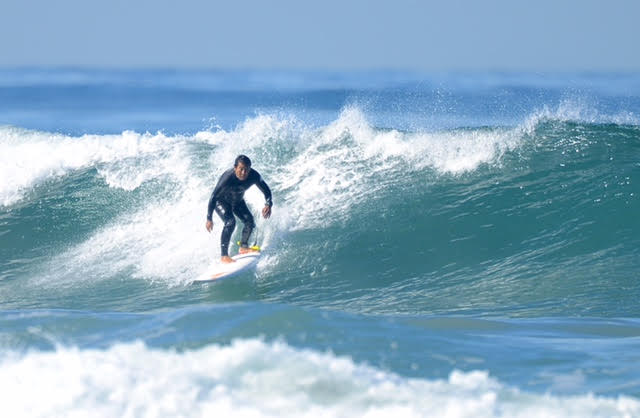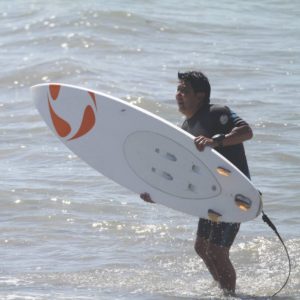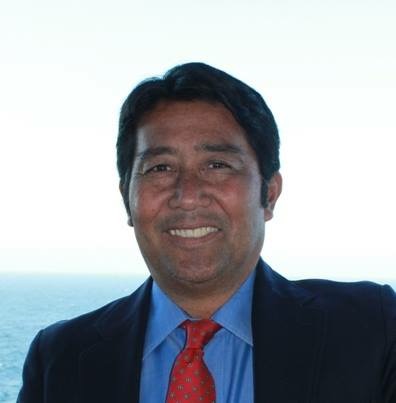
It’s been 22 years since Chris Kimura was told he would only live another five years after he was diagnosed with Castleman disease.
In 1994, Chris was an active, vibrant 28-year-old who surfed, ran, golfed and squeezed as much adventure out of life as he could. But that same year, he noticed that one of his lymph nodes had become very swollen in his neck. His friend, who happened to be a doctor, urged him to get that lymph node biopsied right away.
That biopsy revealed the scariest and most shocking news of Chris’ life. He has a rare disease known as multi-centric Castleman disease (CD). Castleman disease is an obscure lymph node disease that resembles the more common lymphoma. Known also as giant lymph node hyperplasisa, the disease was first discovered and diagnosed in the 1950s. CD is not actually cancer, rather it is an auto-immune disorder that causes overgrowth of cells in the lymph node system with possible enlargement of organs and organ failure.
Because CD is so rare, Chris had a hard time finding any information about it. He gathered what info he could from a friend in the biotech community and from his family and close friends. The prognosis was not good. He was told he had 3-5 years to live.
“I was scared, I was only 28 and having to face my own mortality,” says Chris. “Twenty year olds aren’t supposed to have to deal with that.”
Chris’ quality of life took a huge hit from Castleman disease

Chris began his treatment with Dr. James Sinclair and was put on a recommended chemotherapy dose, but was told that the chemo efficacy would diminish until there were no other options. Chris was asymptomatic for the next three years. In 1997, his CD became more aggressive and he began to experience severe fatigue.
His hemoglobin, a protein found in the blood that transports oxygen, dropped to 6.6. Normal hemoglobin should be between 12.5-18.5 percent of blood content. Because of this dramatic drop, his lung function became compromised. He couldn’t walk up a flight of stairs, and he slept 36 hours straight at times.
“That’s when I got really scared. I couldn’t golf, run or do my passion of surfing, which I had been doing since a child. I didn’t know what my life span would be.”
Chris’ quality of life had taken a huge drop. He wasn’t able to do anything he loved anymore. He visited Dr. Sinclair – a family friend who had happened to treat his grandmother when she had cancer. At the time Chris was the only CD patient that Dr. Sinclair had seen.
Groundbreaking treatment from cCARE’s Dr. Sinclair
In 2008, Dr. Sinclair and a colleague applied for Chris to go under an RnD (Research and Development) drug treatment that was not yet approved in the United States, but was approved in the United Kingdom and Japan. His blood levels became more balanced. The scarring on his lungs actually improved.
Dr. Sinclair was astounded at the results of this drug. Chris has been on this drug for many years and it has continued to treat symptoms from his disease. The drug has been a savior for Chris. He is now able to resume his activities. He’s actually traveling to Peru later this year to surf the longest wave in the world!
Chris says that he has the “best medical team around” and still goes every three weeks for chemotherapy at Dr. Sinclair’s cCARE office. His advice to others is to have hope, a positive attitude and remind yourself that somebody always has it worse.
 Chris is a successful real estate broker in San Diego and works out of his home office. He participates in the Encinitas Rotary and tries to volunteer on a regular basis.
Chris is a successful real estate broker in San Diego and works out of his home office. He participates in the Encinitas Rotary and tries to volunteer on a regular basis.
“The Castleman diagnosis has made me a much better person,” says Chris. “Life is so fleeting, it’s so important for me to put a smile on someone’s face, give back to others, and try to leave this world a better place than I found it!”
For more about Chris’ harrowing journey with Castleman disease, watch him tell his story on YouTube.
